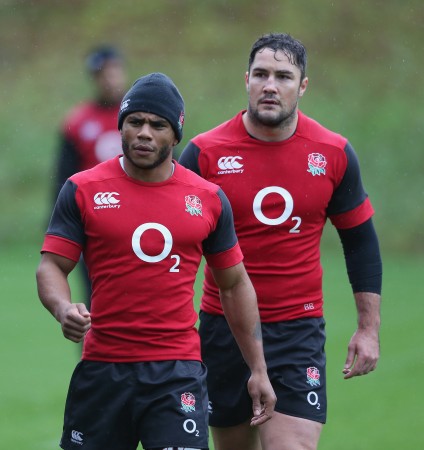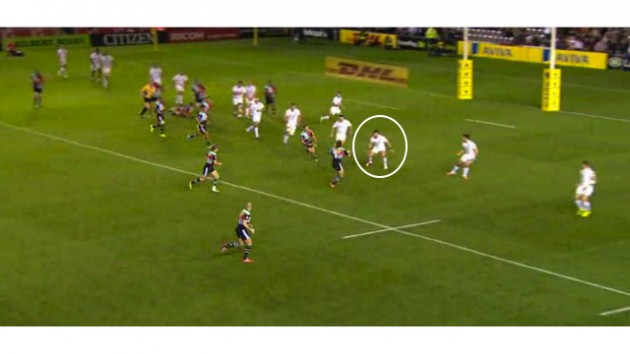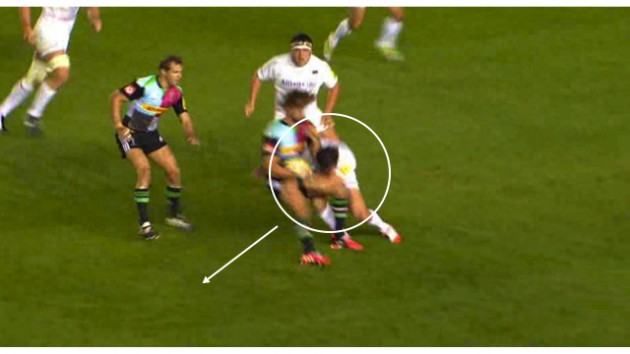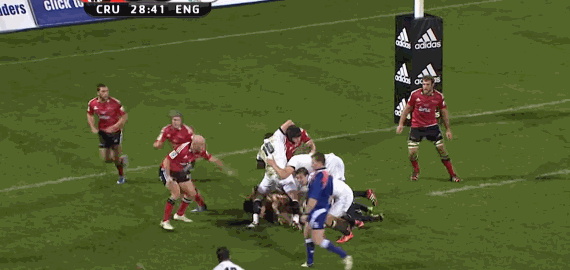England will go on the attack against the All Blacks at Twickenham on Saturday, but their sensible centre will be crucial to structure and success. We analyse why Brad Barritt is so important this weekend.
In terms of positives, there was very little to take from the British and Irish Lions’ midweek defeat to the Brumbies back in June 2013. On a rain-swept night in Canberra, the tourists fielded a scratch side scattered with jet-lagged late arrivals plus recent international retiree Shane Williams.
As a consequence, they gave a confused performance devoid of cohesion. Even a late charge of the cavalry – a replacements bench filled with Test players was emptied on the hour mark – could not ward off a dreary 14-12 reverse.
However, one brief moment in the first half flawlessly portrayed the essence of England centre Brad Barritt, both as a player and a bloke. The Lions were awarded a penalty around 35 metres out, fairly adjacent to the posts. Stuart Hogg stepped up to add a straightforward three points, but saw his attempt bounce down off an upright.
As a Brumbies player collected the loose ball inside his own 22, he was hit by a red bullet – Barritt, who had pursued the kick on the unlikely off-chance of a rebound. Such selfless graft, under the radar yet invaluable, is an indelible hallmark of his career. Given Barritt landed in Australia from a holiday in North America and only a solitary one training session before the game, the effort felt more fitting.
With Luther Burrell and Manu Tuilagi both injured, it feels as though the Saracen is performing another fill-in role this weekend. That said, Stuart Lancaster would not have been at all anxious about picking him in the centre alongside Kyle Eastmond as England look to end a run of four consecutive defeats against New Zealand. In fact, once the squad’s fitness bill had been established, Barritt’s will have been one of the first names on the team sheet. In ink.
For a start, the 28 year-old personifies the Lancaster regime. His Test debut came in the former school teacher’s maiden game in charge, a gritty 13-6 victory at Murrayfield. That afternoon, Barritt looked after a young midfield partner in Owen Farrell and became a mainstay of the subsequent Six Nations campaign, which prioritised togetherness and team culture above everything.
He scored a try in the sensational 38-21 defeat of the All Blacks back in December 2012 – more of that later – and simply is not capable of letting people down. In 18 internationals, he possesses a win ratio just a whisker under 64 per cent. As a purely mischievous, irrelevant comparison, Brian O’Driscoll bowed out on 59 per cent.
Barritt also heads into November in fine form. Defensive solidity is his bread and butter. On club duty, he has made 58 tackles and missed one since the start of September. This clip from Saracens’ 39-0 thrashing of Harlequins shows a typically robust challenge on flanker Luke Wallace:
Obviously tenacity and physicality are on display here, qualities that will be pivotal on Saturday with the likes of Sonny Bill Williams around. Taking a closer look, the technique is spot on as well. Watch Barritt’s body position as Wallace receives Nick Evans’ pass:
On his toes with weight evenly distributed, Barritt is coiled. As we magnify the point of contact, this sound method is emphasised:
Barritt hits with his shoulder, wraps the arms and drives through with his lower limbs. It is an impeccable tackle founded on strong posture. The second string to Barritt’s defensive bow is organisation. A prime example surfaced later in the same game:
Excellent lineout ball provides a perfect platform for Harlequins here, and Jordan Turner-Hall is launched forward by Danny Care. Even so, the burly centre is met behind the gain-line.
Set that against the havoc New Zealand caused on first phase in June’s third Test, carving a Barritt-less backline apart:
Clearly, the opposition is superior and the move more intricate, but England are still exposed drastically. And actually, it all comes down to systems, communication and composure. Note Saracens’ set-up as Turner-Hall takes the ball:
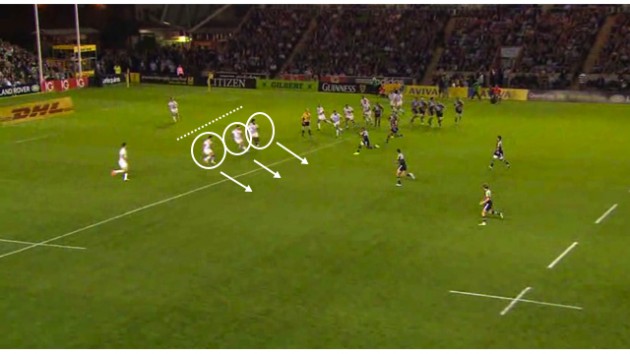 The defenders (Billy Vunipola, Jamie George and Barritt from right to left) are co-ordinated, pro-active and pressing in their tight structure. Back to Hamilton, and England are nowhere near as connected:
The defenders (Billy Vunipola, Jamie George and Barritt from right to left) are co-ordinated, pro-active and pressing in their tight structure. Back to Hamilton, and England are nowhere near as connected:
 Caught unaware by New Zealand’s fast tempo, this looks like a reactive, panicky midfield. Some members of it are tentative, others are rushing up on an individual crusade. Aaron Cruden takes advantage easily.
Caught unaware by New Zealand’s fast tempo, this looks like a reactive, panicky midfield. Some members of it are tentative, others are rushing up on an individual crusade. Aaron Cruden takes advantage easily.
It is hard to imagine such disjointedness happening on Barritt’s watch. The perception of the Durban-born man as merely a brawny blocker is inaccurate though. He offers plenty in attack, and has displayed that against Kiwi sides.
Two pieces of play from England’s win over the Crusaders on this summer’s trip illustrate as much. This short-range try on the half-hour started things off:
A neat step off the left foot and impressive power sees off two tacklers. Later, right at the death in fact, Barritt was on hand for a creative flourish to finish:
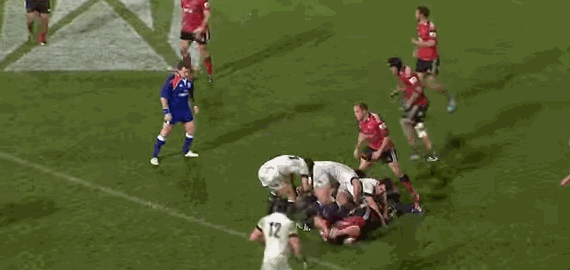 Isolating the point of his grubber, Barritt’s awareness is laid bare. On turnover ball, the backline is quite flat, so going to boot is a better option that risking a forward pass to eventual scorer Chris Pennell:
Isolating the point of his grubber, Barritt’s awareness is laid bare. On turnover ball, the backline is quite flat, so going to boot is a better option that risking a forward pass to eventual scorer Chris Pennell:
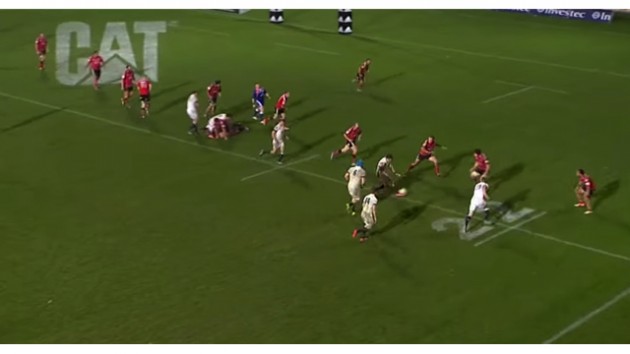 This angle is a good one to gauge both the difficulty of this skill and how Barritt has spotted space in behind the Crusaders. Undoubtedly, this is attacking ingenuity at work. The same invention will be well placed in the same backline as Mike Brown, Semesa Rokoduguni and Jonny May, not to mention Eastmond.
This angle is a good one to gauge both the difficulty of this skill and how Barritt has spotted space in behind the Crusaders. Undoubtedly, this is attacking ingenuity at work. The same invention will be well placed in the same backline as Mike Brown, Semesa Rokoduguni and Jonny May, not to mention Eastmond.
Finally, to a clip Barritt would do well to relive a couple of times before Saturday:
Capitalising on a mightily rare brain fade from Saturday’s opposite number Conrad Smith, Barritt offers a range of qualities. His running line is incisive, the pass to Tuilagi is well timed. Then he realigns quickly enough to snare a return offload and dot down. How much would Lancaster love a repeat?
Burrell, Tuilagi and even Henry Slade may represent more viable long-term options for England looking ahead to the World Cup. Still, Barritt has a wonderful opportunity to press his credentials and prove he is far from a desperate last resort.
To read an in-depth analysis of New Zealand’s haka and RW’s verdict on England’s midfield problem, check out the December issue of Rugby World – in shops now! Visit po.st/RWSub for all the latest Rugby World subscription deals, or find out how to download the digital edition of the magazine at po.st/RWDig.






